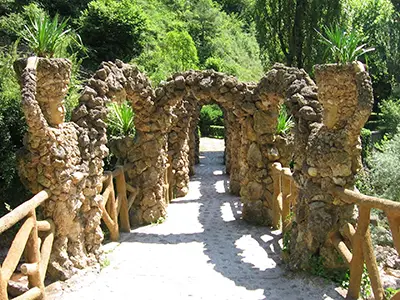Constructed between 1905 and 1906 the Jardins Artigas is a park in the Pobla de Lillet area of Barcelona, Spain, and was designed by Antoni Gaudi the modernist architect. Gaudi was born in 1852 to a coppersmith and grew to hold a great pride in his country and heritage.
Spending much time outdoors in his childhood Gaudi was able to study and appreciate nature at first hand. Later, after completing military service Gaudi studied architecture at the Llotja School and the Barcelona Higher School of Architecture. The Jardins Artigas are representative of Gaudi's many other creations including archways and Catholic symbolism. The gardens were created and named after a wealthy textile magnate as a means of thanks for the hospitality that Gaudi received from his hosts who he stayed with after a visit to one of his chief patrons in Lillet. The gardens were based on a similar but smaller project that Gaudi had already completed at Park Güell in Barcelona.
Unfortunately, by the 1970s the gardens had fallen into a pitiful state of neglect, however, after details of the state of the gardens and their illustrious architect became known to the wider public they were rescued and magnificently restored by the Polytechnic University of Catalonia in the 1990s. The gardens are currently owned by the local authorities and are open to members of the public.
Techniques
In line with other outdoor environments that Gaudi had designed, the Jardins Artigas was designed to be sympathetic to the natural environment and trademark Gaudi features include an artificial grotto and religious images. The architect designed the gardens specifically to appeal to visitors with various points of interest at strategic points such as the La Glorieta, La Cova with catenary arches, El Beranador with male and female forms, and La Cascada – a stone fountain embellished with plant motifs. The Christian imagery can be seen in the angel of St Matthew at the fountain, the eagle of St John at the Coix arch bridge, the bull of St Luke at the Bull Fountain and the lion of St Mark at La Pergola.
Influences
Gaudi's work was strongly influenced by the things he was passionate about – namely religion, nature and architecture. His attention to detail is clear in his creations and often included a range of crafts such as wrought iron, forging, ceramics and stained glass. Gaudi was part of the Mondernista movement which took inspiration from neo-Gothic art and Oriental techniques which were incorporated into modernist pieces. However, Gaudi developed a unique style which was organic and used the flow of natural forms in the design.
Summary
Gaudi's work still delights and intrigues architects and tourists from all over the globe, and his masterpiece, the still incomplete Sagrada Familia, is the most visited monument in Spain. The Jardins Artigas clearly demonstrates the lasting appeal of his imaginative, natural and inspiring designs. Gaudi's very distinctive style is instantly recognizable in the unique, beautiful and surreal nature of the gardens which invite the visitor to explore and enjoy the almost fairytale bridges, turrets and figures.




